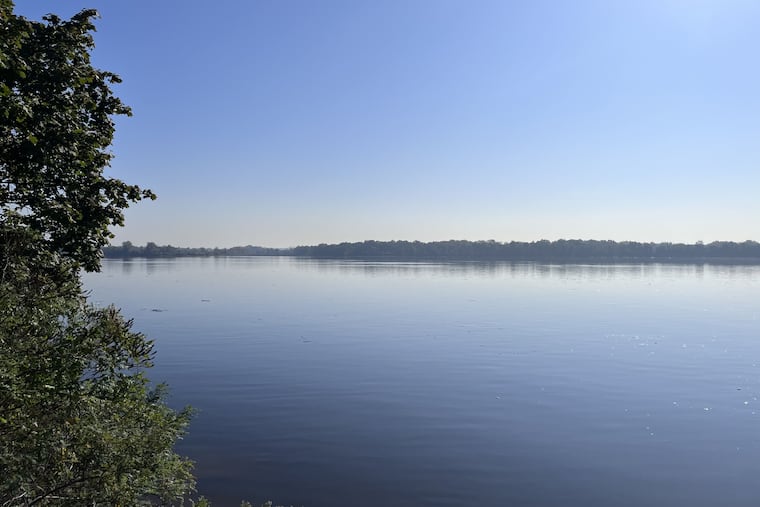The Delaware River is going to get a lot better for fish in Philly
For the first time since 1967, the U.S. Environmental Protection Agency is proposing that the Delaware River as it runs through Philly have a higher level of dissolved oxygen, which fish need.

The Delaware River as it flows from Philadelphia to Wilmington has long been the most polluted stretch of the 330-mile-long waterway for struggling fish because regulations have allowed it.
The U.S. Environmental Protection Agency on Thursday proposed a higher standard for levels of oxygen in the water for the two-city stretch, a protection other parts of the river have enjoyed for decades. Raising oxygen, they say, will help aquatic life such as striped bass, American shad, and the federally endangered Atlantic sturgeon thrive.
The agency estimates the new rule would collectively cost 20 wastewater-treatment plants that discharge into the river $137 million a year to comply. It is unclear how, or if, ratepayers would be affected.
The rule falls under a category aimed at protecting aquatic life and does not tackle pollution harmful to human health.
Meanwhile, the Philadelphia Water Department said this week that it is planning a new $74 million facility as a way of improving the river’s oxygen levels.
What would the new regulation do?
The EPA’s proposed rule would raise the current standard for dissolved oxygen to protect annual fish spawning, larval development, and juvenile development from March through October. That, officials say, would bring the river closer to the Clean Water Act’s goal of making all rivers swimmable and fishable.
“In the Biden administration, we’re really trying to get things on track,” EPA’s Region 3 administrator Adam Ortiz said. “And to make sure that no matter where people live, they have equal access to a healthy environment.”
Environmental groups, including the Delaware Riverkeeper Network, PennEnvironment, and PennFuture, all say the new standards are welcome but still not good enough.
“This is a definite and significant improvement in dissolved oxygen levels during the critical months for Atlantic sturgeon,” said Maya van Rossum, leader of the Delaware Riverkeeper Network. “But the EPA does not go far enough to fully reflect what the science tells us, which is that they need to do more and better. Atlantic sturgeon are at precariously low levels so we really have to follow the science in order to try to save them.”
The lower standard has been in place since 1967 along the 20-mile stretch from Philadelphia to Wilmington, part of the tidal estuary that empties into the Atlantic Ocean. Most summers, the Philly zone experiences low levels of dissolved oxygen, a measure of the amount of oxygen in water, which can impede fish survival.
The stretch of river is the only critical waterway in EPA’s Region 3 that has not been afforded the protection. Region 3 includes Pennsylvania, Delaware, the District of Columbia, Maryland, Virginia, and West Virginia. New Jersey, Ortiz noted, is in Region 2, but will also be part of the protection, as the waterway runs through Camden.
“The Delaware River, in some ways, has been lagging in those protections,” Ortiz said.
The public has 60 days to comment on the rule and two virtual public hearings are planned.
Officials expect to hear from environmental groups, who have been pushing for higher standards for years, and water-treatment companies, which will have to install new technology. The EPA hopes to formally adopt the rule by December 2024.
The Delaware River was once the dominant spawning grounds in the United States for Atlantic sturgeon, but the population has dwindled significantly. The river now has one of the weakest populations.
What causes low oxygen levels?
The biggest contributor to low oxygen rates is wastewater-treatment plants, particularly nine key plants along the river, including those owned by the Philadelphia Water Department (PWD). The plants release treated wastewater into the river. The wastewater contains ammonia, which can come from meat, blood, urine, and cleaning products. Ammonia eats up oxygen in the river as it converts to nitrate. That leaves less oxygen for fish.
Plants operated by Philadelphia, the Camden County Municipal Authority, and Wilmington will all have to comply with new permitting overseen by the state DEPs in coming years. The plants were built decades ago without a way to get rid of the large amounts of ammonia in human waste.
Philadelphia Water Department operates three wastewater-treatment plants. Its Southwest Plant is the largest discharger of ammonia into the river. The department is proposing to build a new facility at the Southwest Plant and is applying for a $60 million low-interest loan from PennVest, a Pennsylvania agency that funds sewer, stormwater, and drinking water projects. If PWD gets the loan, it would bid for the project next summer and complete the project by 2027.
The Southwest Plant was built in the 1950s and had major upgrades in the 1980s to comply with the Clean Water Act. Samantha O’Connor, a facilities planning manager at PWD, said Wednesday during a presentation about the proposed facility that the city’s plants were equipped to remove most organic material to meet regulations. But additional treatment is required to remove ammonia.
“This project is driven by regulations, aquatic life health, and cost-effectiveness in reducing ammonia discharge,” O’Connor said.